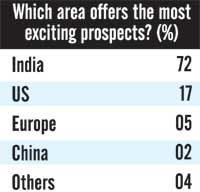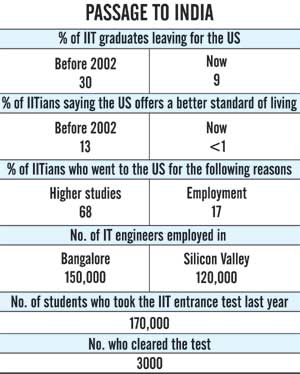| Brain Gain |
|
Drawn by a vibrant economy, world class facilities and exciting work opportunities in India, most IIT graduates are not only staying put, thousands are showing their back to the west and charting a passage back home
|
|
Rakesh K. Simha
|
|
|
Not long after graduating from the Indian Institute of
Technology-Kanpur, Manu Agarwal left for the US holding a one-way plane ticket and little else. “At that time, in the 1990s, America was still very much the land of opportunity,” he says. “You studied at
IIT, went on to a top American college and then waited for the greenbacks and the green card.” Agarwal first got his MS at the University of Minnesota. “It was much easier to get good grades at Minnesota U,” says Agarwal on college education in the US. “At
IITs, the level of competition is an order of magnitude higher.” Having earned his stripes, Agarwal joined Wafer Scale Integration where he spent most of his time doing research on flash memory chips.
For Agarwal, though, it wasn’t exciting enough. In 1997 he returned to Mumbai to co-found Design Expo, a company whose flagship product was an instant messaging solution. “The Internet was still in its infancy in India and the IT industry was young and rapidly growing,” says
Agarwal. By the second year, his company posted revenues of about $171 million, and in the fourth year hired 24 IIT graduates, which probably is a world record in terms of hiring graduates from that institution! In 2003, he founded ANMsoft Technologies, which competes with IBM in providing offshore software development and technology solutions in Internet-based banking, travel, media and retail verticals. Mission accomplished.
However, the return journey wasn’t accidental. For Agarwal the plan to come back to India was always on the agenda. There were a number of reasons for going home. “It was the desire to be more creative and productive in India and to come back to people I knew were the more important ones,” he says.
Often it doesn’t make any difference where you are located. “We have good engineers here. And, the Internet being in place, sharing information and getting to know about the latest technologies is not difficult,” says
Agarwal. “Also, there are not many competitors in Mumbai to hog on the human resources. The idea was to not only get access to suitable engineering graduates, but also not to place all the emphasis on retaining them.”
Make space, ladies and gentlemen, the brains are coming back! According to a survey by global analytical and research firm
Evalueserve, graduates from the IITs believe India is fast catching up with the US for the range and quality of career prospects. Soak up these figures: Over 30 per cent of IITians who graduated during 1964 and 2001 moved to the US whereas only 9 per cent did so – or will do so – during 2002 and 2008. The drop in the number of IITians who believe the US offered a “better standard of living” has been remarkable, from 13 per cent to almost zero. It’s a far cry from those days when IIT Chennai was considered America’s 51st state!
Most tellingly, according to Evalueserve, 72 per cent of IITians predicted that in 10 years India would be the country holding the most promise of success, with only 17 per cent choosing the US and 5 per cent Europe.
So has the honeymoon between IITians and Corporate America ended? Not from the other side, at least. Most American companies would like to protect their Indian hires with the same tenacity that NHL clubs hold onto their Russian ice hockey superstars. But now an increasing number of IITians prefer the rupee to the once mighty dollar. |







|
|
Engineers and recruiters cite a raft of reasons for the reverse
migration, from rising living standards in India to a sense among some engineers that it’s time to give back something to the communities that educated them. Mostly, though, it’s because India is now seen
as a centre for innovation.
The point of “inflexion” with respect to this change seems to have occurred with the graduating class of 2002 and likely correlates to the growth of India’s economy, which has been 8-9 per cent a year in real terms and 14-15 per cent in nominal terms.

A substantial percentage of IITians who wanted to move to the US, actually did not make the move. For example, 35 per cent of recent graduates from 2002-2007 who wanted to move to the US eventually did not, a number considerably higher than the corresponding group from the 1964-2001 graduating classes. Some reasons cited by the respondents included stringent visa regulations following the 9/11 terrorist attack, the high cost of living, limited scholarships, and high tuition fees and the perception of reduced employment opportunities and a poorer life in the US.
What, however, is less openly discussed is that the rise of the Indian knowledge worker is terrifying Americans. While many see India’s digital workers as bearers of new prosperity to a deserving nation and vital partners of Corporate America, others see them as shock troops in the final assault on good-paying jobs. Information technology consultant Meta Group of Connecticut says big US companies are shedding 500 to 2,000 IT staffers at a time. These people won’t get reabsorbed into the workforce until they get the right skills. Many who do often lose 30 per cent of their former pay package.
Indians employed in the US can feel the backlash. “There is a great deal of resentment in American workplaces,” says a techie who works in Fremont-based AMD Corp. “Just go to Internet tech forums and see the level of envy of and dislike for Indians. It’s almost comical, coming from a country that considers itself a superpower. There’s a lot of racial outburst, and while others meekly accept it, we Indians counterattack quite hard.” The upshot: at any given time 70 per cent of Indians are considering returning home.
Another major factor is that in an era when travel and communication are getting quicker and easier, the linear idea of a one-way brain drain is
givin g way to a different paradigm of brains that circulate between native and adopted countries. You don’t really have to be physically present in, say, Silicon Valley to work there. g way to a different paradigm of brains that circulate between native and adopted countries. You don’t really have to be physically present in, say, Silicon Valley to work there.
That pattern is now emerging in India, which watched as perhaps 25,000 of its top graduates left for the US since the late 1960s. In the years when the technology explosion hit America, these Indians emerged as major players and now run more than 750 technology companies in California’s Silicon Valley alone.
Some of those who left say they are getting involved in India now because they have succeeded as entrepreneurs and have money to spare, because there are economic opportunities in India and because India is more open to their participation in the country’s affairs. Pradeep Singh, 50, a graduate of IIT Delhi made his millions from his stock options at Microsoft. He quit in the mid-1990s to start his own company, Aditi, which provides customer service via e-mail from India for corporations abroad. He now has two companies, lives four months a year in Bangalore and eight in Seattle, and employs 600 people -- 350 of them in India.
And there’s Rakesh Mathur, 43, a graduate of IIT Mumbai. He and two other Indians, Venky Harinarayan and Anand Rajaraman, founded a Silicon Valley company, Junglee.com -- an early comparison-shopping engine on the Web. It was sold in 1998 to Amazon.com in a stock deal that made Mathur $90 million richer. He still has homes in California and Seattle, but he also has one in Pune. Mathur has given $1 million to his alma mater and started a new company, Purpleyogi.com, with offices in Bangalore and Mountain View.
Earlier, it used to be a struggle to get good work in India. US companies would transfer components of the products and get bugs fixed. Someone abroad always decided what to do. Now this has changed. Complete products are being developed here. By some estimates, there are more IT engineers in Bangalore (150,000) than in Silicon Valley (120,000). Meta figures at least one-third of new IT development work for big US companies is done overseas, with India the biggest site. And India could start grabbing jobs from other sectors. AT Kearney predicts 500,000 financial-services jobs will go offshore by the end of 2008. US governments are increasingly using India to manage everything from accounting to their food-stamp programmes. Even the US Postal Service is taking work there. Auto engineering and drug research could be next.
By 2008, forecasts consultancy giant McKinsey & Co (which, by the way, is headed by IIT Delhi graduate Rajat Gupta), IT services and back-office work in India will swell fivefold, to a $57 billion annual export industry employing 4 million people and accounting for 7 per cent of India’s gross domestic product. That growth is inspiring more of the best and brightest to stay home rather than migrate.
Says Karthik Narayanaswamy, an IIT Mumbai graduate, who works in management consulting in Delhi: “Where it once was a great asset to boast American experience, now everyone works in India for at least a few years. If you haven’t done it, it can actually be a problem for career development. Brought up in Kuwait, I didn’t want to miss the boat.”
Of course, India can, and does, get under your skin. Often these overachievers are appalled by stifling bureaucracy, stonewalling politicians, lousy traffic, and creaky infrastructure. But IITians are prepared for the worst. “I didn’t face many disappointments,” says IIT Kanpur graduate Ranjan Bose, Agarwal’s former partner in Design Expo. “I had a realistic picture in mind. I was prepared for slow phone connections... let’s just say my expectations were low. If you and your company are well organised, you won’t face too many problems, except perhaps when dealing with the government.”
As things improve in India the trend is clear: in the minds of IIT graduates, the West is no longer best.
|
| |
|
|
|
July 2008
|
|


|
|
|
|